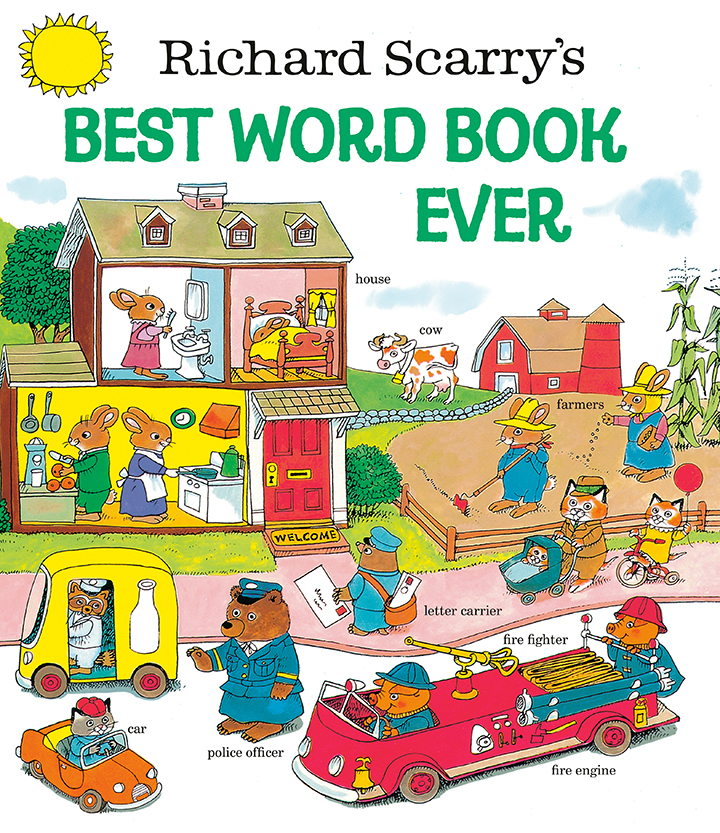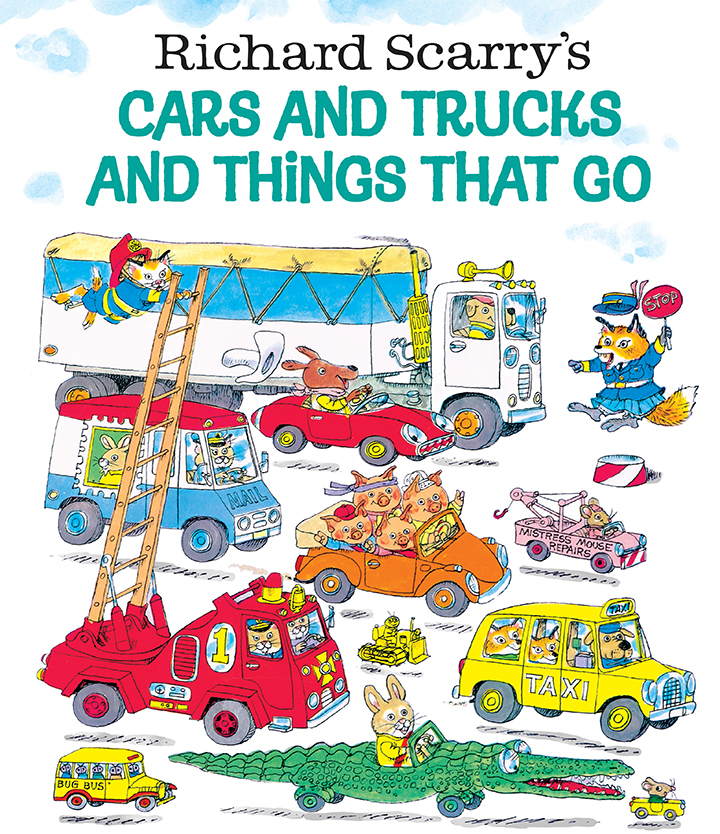 Back in 1951, it must have been an unusual sight to see children’s book illustrator Richard Scarry tooling around the streets of Ridgefield with his wife Patsy in their snappy black MGTC sports car, especially amidst all the family filled Chevys and Fords. Fresh off a successful nine book run illustrating Little Golden Books and following a European vacation where Scarry acquired the iconic Tyrolean hat his characters wore, the couple left the hustle and bustle of New York City for the quiet confines of Ridgefield. That was before Richard Scarry’s breakthrough books like The Big Word Book or the Busytown series were published and before he brought Lowly Worm, Huckle Cat, Police Sergeant Murphy or Gorilla Bananas to life.
Back in 1951, it must have been an unusual sight to see children’s book illustrator Richard Scarry tooling around the streets of Ridgefield with his wife Patsy in their snappy black MGTC sports car, especially amidst all the family filled Chevys and Fords. Fresh off a successful nine book run illustrating Little Golden Books and following a European vacation where Scarry acquired the iconic Tyrolean hat his characters wore, the couple left the hustle and bustle of New York City for the quiet confines of Ridgefield. That was before Richard Scarry’s breakthrough books like The Big Word Book or the Busytown series were published and before he brought Lowly Worm, Huckle Cat, Police Sergeant Murphy or Gorilla Bananas to life.
In a recent interview from his home in Vienna, Huck (Richard McClure Scarry Jr.) who took the reins when his father died in 1994, said he has no idea why his parents chose Ridgefield when they decided to escape the crowded city. He speculates that it could have been to move nearer to close friends. Or perhaps they wanted to be in the country to raise the family they soon hoped
to have.
Regardless, it was a pivotal time in Scarry’s career. That was the year he ventured out to both write and illustrate his first solo book. With the publication of The Great Big Car and Truck Book where Richard and Patsy can be seen bouncing along in their signature sports car on the title page, he began to find his niche.
The famed writer was 32 years old when he and Patsy moved to a cramped little cottage on Conklin Farm located on North Street. Soon after, Patsy who originally worked in advertising, decided that she would write her own Little Golden Books, some of which Scarry illustrated including The Bunny Book, dedicated to their son Huck, who was born in 1953.
Huck surmises that they eventually parted editorial ways because they “both had big egos.” Before ending their collaboration, however, they published among others, Good Night Little Bear, modeled after the family routine of getting Huck to bed each night. While Huck doesn’t remember much about his first five years living in Ridgefield, the illustrations resonate. Wide plank floors, a small staircase, an old clock, midcentury furnishings, the big stone fireplace, a garden and especially his mother sitting at her Singer sewing machine are all drawn from life in their cottage. Huck thinks his parents must have been oracles because on the last page of The Bunny Book, another of their collaborative efforts, they depict a grown child tucking his own children into the four bunkbeds lining the wall. Huck only realized later, as the father of four, how coincidental that was.
 Most of Scarry’s earlier illustrations were painted, requiring a lot of time and technique. It was his transition to larger-format books where pages were crowded with lots of different things that he began to draw his illustrations instead, thereby saving time and giving him more creative license. Using a technique called Blueboards, he first finished line illustrations that would be sent to a photoengraver where a transparent offset film for printing would be made. The film was used to print his illustration in a very pale blue tint onto an illustration board or paper. Scarry would then color-in his books with gouache paints using the pale blue lines for guidance.
Most of Scarry’s earlier illustrations were painted, requiring a lot of time and technique. It was his transition to larger-format books where pages were crowded with lots of different things that he began to draw his illustrations instead, thereby saving time and giving him more creative license. Using a technique called Blueboards, he first finished line illustrations that would be sent to a photoengraver where a transparent offset film for printing would be made. The film was used to print his illustration in a very pale blue tint onto an illustration board or paper. Scarry would then color-in his books with gouache paints using the pale blue lines for guidance.
“He would have the black-line overlay film to check his colors and see that they matched up with the drawings,” says Huck. Scarry would then paint one color at a time—first everything that was red, then yellow, blue, green and so on. As he got old enough, Huck would often help him fill in the colors.
Wanting more space and less isolation, the Scarry’s moved to Westport in 1958. Five years later he had his first best seller with Richard Scarry’s Best Word Book Ever. The last books created while he lived in the United States were the Busytown books and with them came the birth of his most memorable characters.
Huck describes his family life as straight out of a fairy tale with his dad working from home, always taking a break to toss the ball or take him sailing. They would often climb into the car for a family adventure. Their love of travel was instilled in their son early and when Huck was ten, they sailed to Europe for two months where equipped with a Eurail pass, they basically lived on a train. Busy Busy World was loosely based on those experiences.
One day Scarry announced that all he needed to work were his papers, pencils and a post office, so they packed only three small suitcases and moved to Lausanne, Switzerland for a year where they would be close to the ski slopes and where they might learn to speak French.
“We had no residency permits or visas. We just turned up there,” says Huck, who by then was in his teens. When the local police asked him to explain himself, Scarry showed up with an armful of his books. “The chief, who had children of his own, pulled out a residency permit, stamped it and said, welcome,” says Huck.
Later, the family moved to Gstaad, a resort town known for skiing and hiking where Scarry lived until his death in 1994. Patsy followed a year later. In his later years, despite failing health, Scarry continued to work, often with Huck by his side. While Huck was a talented children’s book author himself, he had reservations about keeping his father’s work alive. “I knew I could write. I knew I could draw,” he says. “But could I draw his characters?”
What he found is that while it is always a challenge to emulate his father’s style, he was drawn to the many interesting stories these characters had to tell. “The fun part of continuing with my father’s books is that I let myself go and have fun being silly, trying to emulate my father’s sense of humor,” he says. “Often when I’m working I’ll find myself smiling and I feel his spirit right there looking over my shoulder. It has made me realize just how brilliant my father was.” •